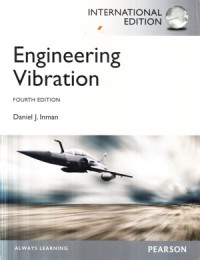Text
Engineering vibration
This book is intended for use in a first course in vibrations or structural dynar for undergraduates in mechanical, civil, and aerospace engineering or engineer¬ing mechanics. The text contains the topics normally found in such cou: in accredited engineering departments as set out initially by Den Hartog and refined by Thompson. In addition, topics on design, measurement, and computa¬tion are addressed.
Pedagogy
Originally, a major difference between the pedagogy of this text and competing texts is the use of high level computing codes. Since then, the other authors of vibrations texts have started to embrace use of these codes. While the book is written so that the codes do not have to be used, I strongly encourage their use. These codes (Mathcad®, MATLAB®, and Mathematica®) are very easy to use. at the level of a programmable calculator, and hence do not require any prereq¬uisite courses or training. Of course, it is easier if the students have used one or the other of the codes before, but it is not necessary. In fact, the MATLAB* codes can be copied directly and will run as listed. The use of these codes greatly enhances the student's understanding of the fundamentals of vibration. Just as a picture is worth a thousand words, a numerical simulation or plot can enable a completely dynamic understanding of vibration phenomena. Computer calcula¬tions and simulations are presented at the end of each of the first four chapters. After that, many of the problems assume that codes are second nature in solving vibration problems.
Another unique feature of this text is the use of "windows," which are distributed throughout the book and provide reminders of essential informa-tion pertinent to the text material at hand. The windows are placed in the text at points where such prior information is required. The windows are also used to summarize essential information. The book attempts to make strong connections to previous course work in a typical engineering curriculum. In particular, refer¬ence is made to calculus, differential equations, statics, dynamics, and strength of materials course work.
Ketersediaan
Informasi Detail
- Judul Seri
-
-
- No. Panggil
-
620.3 Inm e
- Penerbit
- London : Pearson., 2014
- Deskripsi Fisik
-
720 hal. : il. ; 23 cm.
- Bahasa
-
English
- ISBN/ISSN
-
9780273768449
- Klasifikasi
-
620.3
- Tipe Isi
-
-
- Tipe Media
-
-
- Tipe Pembawa
-
-
- Edisi
-
Ed. IV
- Subjek
- Info Detail Spesifik
-
-
- Pernyataan Tanggungjawab
-
-
Versi lain/terkait
Tidak tersedia versi lain
Lampiran Berkas
Komentar
Anda harus masuk sebelum memberikan komentar

 Karya Umum
Karya Umum  Filsafat
Filsafat  Agama
Agama  Ilmu-ilmu Sosial
Ilmu-ilmu Sosial  Bahasa
Bahasa  Ilmu-ilmu Murni
Ilmu-ilmu Murni  Ilmu-ilmu Terapan
Ilmu-ilmu Terapan  Kesenian, Hiburan, dan Olahraga
Kesenian, Hiburan, dan Olahraga  Kesusastraan
Kesusastraan  Geografi dan Sejarah
Geografi dan Sejarah